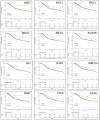DNA Damage Response during Replication Correlates with CIN70 Score and Determines Survival in HNSCC Patients
- PMID: 33801877
- PMCID: PMC7998578
- DOI: 10.3390/cancers13061194
DNA Damage Response during Replication Correlates with CIN70 Score and Determines Survival in HNSCC Patients
Abstract
Aneuploidy is a consequence of chromosomal instability (CIN) that affects prognosis. Gene expression levels associated with aneuploidy provide insight into the molecular mechanisms underlying CIN. Based on the gene signature whose expression was consistent with functional aneuploidy, the CIN70 score was established. We observed an association of CIN70 score and survival in 519 HNSCC patients in the TCGA dataset; the 15% patients with the lowest CIN70 score showed better survival (p = 0.11), but association was statistically non-significant. This correlated with the expression of 39 proteins of the major repair complexes. A positive association with survival was observed for MSH2, XRCC1, MRE11A, BRCA1, BRCA2, LIG1, DNA2, POLD1, MCM2, RAD54B, claspin, a negative for ERCC1, all related with replication. We hypothesized that expression of these factors leads to protection of replication through efficient repair and determines survival and resistance to therapy. Protein expression differences in HNSCC cell lines did not correlate with cellular sensitivity after treatment. Rather, it was observed that the stability of the DNA replication fork determined resistance, which was dependent on the ATR/CHK1-mediated S-phase signaling cascade. This suggests that it is not the expression of individual DNA repair proteins that causes therapy resistance, but rather a balanced expression and coordinated activation of corresponding signaling cascades.
Keywords: CIN70 score; Chk1 inhibition; HNSCC; chromosomal instability (CIN); radiosensitization; radiotherapy; replication stress.
Conflict of interest statement
The authors declare no conflict of interest.
Figures





Similar articles
-
Prevention of DNA Replication Stress by CHK1 Leads to Chemoresistance Despite a DNA Repair Defect in Homologous Recombination in Breast Cancer.Cells. 2020 Jan 17;9(1):238. doi: 10.3390/cells9010238. Cells. 2020. PMID: 31963582 Free PMC article.
-
Posttranscriptional control of the replication stress response via TTP-mediated Claspin mRNA stabilization.Oncogene. 2020 Apr;39(16):3245-3257. doi: 10.1038/s41388-020-1220-9. Epub 2020 Feb 21. Oncogene. 2020. PMID: 32086441
-
Exploiting Chromosomal Instability of PTEN-Deficient Triple-Negative Breast Cancer Cell Lines for the Sensitization against PARP1 Inhibition in a Replication-Dependent Manner.Cancers (Basel). 2020 Sep 29;12(10):2809. doi: 10.3390/cancers12102809. Cancers (Basel). 2020. PMID: 33003585 Free PMC article.
-
Claspin - checkpoint adaptor and DNA replication factor.FEBS J. 2019 Feb;286(3):441-455. doi: 10.1111/febs.14594. Epub 2018 Jun 29. FEBS J. 2019. PMID: 29931808 Review.
-
The ATM-Chk2 and ATR-Chk1 pathways in DNA damage signaling and cancer.Adv Cancer Res. 2010;108:73-112. doi: 10.1016/B978-0-12-380888-2.00003-0. Adv Cancer Res. 2010. PMID: 21034966 Review.
Cited by
-
Targeting BRD4: Potential therapeutic strategy for head and neck squamous cell carcinoma (Review).Oncol Rep. 2024 Jun;51(6):74. doi: 10.3892/or.2024.8733. Epub 2024 Apr 12. Oncol Rep. 2024. PMID: 38606512 Free PMC article.
-
Beyond the Double-Strand Breaks: The Role of DNA Repair Proteins in Cancer Stem-Cell Regulation.Cancers (Basel). 2021 Sep 26;13(19):4818. doi: 10.3390/cancers13194818. Cancers (Basel). 2021. PMID: 34638302 Free PMC article. Review.
-
Chromosomal instability and its effect on cell lines.Cancer Rep (Hoboken). 2023 Jun;6(6):e1822. doi: 10.1002/cnr2.1822. Epub 2023 Apr 24. Cancer Rep (Hoboken). 2023. PMID: 37095005 Free PMC article. Review.
-
Survival association of XRCC1 for patients with head and neck squamous cell carcinoma: A systematic review and meta-analysis.Front Genet. 2023 Jan 5;13:1035910. doi: 10.3389/fgene.2022.1035910. eCollection 2022. Front Genet. 2023. PMID: 36685969 Free PMC article. Review.
-
A prognostic model for laryngeal squamous cell carcinoma based on the mitochondrial metabolism-related genes.Transl Cancer Res. 2025 Feb 28;14(2):966-979. doi: 10.21037/tcr-24-1436. Epub 2025 Feb 18. Transl Cancer Res. 2025. PMID: 40104737 Free PMC article.
References
-
- Dubot C., Bernard V., Sablin M.P., Vacher S., Chemlali W., Schnitzler A., Pierron G., Ait Rais K., Bessoltane N., Jeannot E., et al. Comprehensive genomic profiling of head and neck squamous cell carcinoma reveals FGFR1 amplifications and tumour genomic alterations burden as prognostic biomarkers of survival. Eur. J. Cancer. 2018;91:47–55. doi: 10.1016/j.ejca.2017.12.016. - DOI - PubMed
-
- Verhagen C.V.M., Vossen D.M., Borgmann K., Hageman F., Grenman R., Verwijs-Janssen M., Mout L., Kluin R.J.C., Nieuwland M., Severson T.M., et al. Fanconi anemia and homologous recombination gene variants are associated with functional DNA repair defects in vitro and poor outcome in patients with advanced head and neck squamous cell carcinoma. Oncotarget. 2018;9:18198–18213. doi: 10.18632/oncotarget.24797. - DOI - PMC - PubMed
-
- Wurster S., Hennes F., Parplys A.C., Seelbach J.I., Mansour W.Y., Zielinski A., Petersen C., Clauditz T.S., Munscher A., Friedl A.A., et al. PARP1 inhibition radiosensitizes HNSCC cells deficient in homologous recombination by disabling the DNA replication fork elongation response. Oncotarget. 2016;7:9732–9741. doi: 10.18632/oncotarget.6947. - DOI - PMC - PubMed
Grants and funding
LinkOut - more resources
Full Text Sources
Other Literature Sources
Research Materials
Miscellaneous

